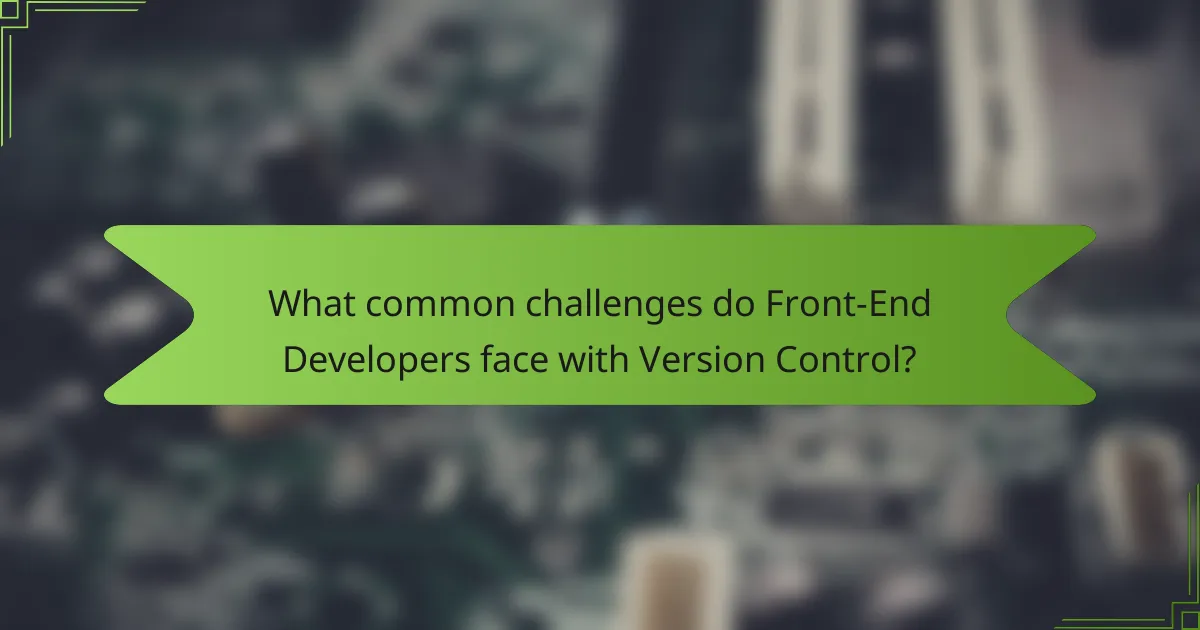Version control best practices are essential for front-end developers to enhance collaboration and streamline workflows. Key practices include using meaningful commit messages, maintaining a clean branch structure, and regularly merging changes to keep the main branch updated. Developers should utilize pull requests for effective code reviews, which improve code quality and team collaboration. Additionally, addressing common challenges such as merge conflicts and branching issues is crucial for maintaining an organized repository. Implementing these strategies can significantly boost productivity and project management efficiency.

What are Version Control Best Practices for Front-End Developers?
Version control best practices for front-end developers include using meaningful commit messages, maintaining a clean branch structure, and regularly merging changes. Meaningful commit messages help describe the purpose of changes clearly. A clean branch structure aids in organizing features and bug fixes effectively. Regularly merging changes ensures that the main branch remains up-to-date and reduces conflicts. Developers should also utilize pull requests for code reviews. This practice enhances code quality and team collaboration. Additionally, it is crucial to keep the repository organized by removing stale branches. Following these best practices can lead to more efficient workflows and better project management.
How do Version Control Systems benefit Front-End Development?
Version Control Systems (VCS) enhance Front-End Development by enabling efficient collaboration and code management. They allow multiple developers to work on the same project simultaneously without conflicts. VCS tracks changes, making it easy to revert to previous versions of code. This feature reduces the risk of losing work due to errors or bugs. It also facilitates code reviews, improving overall code quality. According to a study by GitHub, teams using VCS report a 40% increase in productivity. Additionally, VCS supports branching and merging, allowing developers to experiment with new features without affecting the main codebase. This flexibility is crucial in rapidly evolving front-end environments.
What are the key features of Version Control Systems?
Version Control Systems (VCS) manage changes to source code over time. Key features include tracking changes, allowing collaboration, and maintaining version history. VCS enables multiple users to work on the same project simultaneously without conflicts. It provides branching and merging capabilities to explore different development paths. Additionally, VCS allows for easy rollback to previous versions. This feature is critical for recovering from errors or unwanted changes. Security measures in VCS protect against data loss and unauthorized access. Popular systems like Git and Subversion exemplify these features.
How does Version Control enhance collaboration among developers?
Version control enhances collaboration among developers by allowing multiple users to work on the same project simultaneously. It tracks changes made to the codebase, ensuring that all modifications are recorded. This system reduces the risk of conflicts when merging contributions from different developers. Developers can review each other’s changes through pull requests, promoting code quality and knowledge sharing. Version control also facilitates reverting to previous versions if issues arise. According to a 2021 study by GitHub, teams using version control experience a 20% increase in productivity due to improved collaboration. This structured approach fosters a more organized and efficient development process.
Why is it essential to follow Version Control Best Practices?
Following version control best practices is essential for maintaining code integrity and collaboration. These practices ensure that changes are tracked systematically. They prevent conflicts and facilitate collaboration among team members. Best practices also enhance project organization, making it easier to manage multiple versions of code. According to a 2020 survey by GitHub, teams using version control effectively report a 25% increase in productivity. This demonstrates the tangible benefits of adhering to established protocols. Furthermore, best practices support easier debugging and rollback of changes when necessary. Ultimately, they contribute to a more efficient and reliable development process.
What risks are associated with poor Version Control practices?
Poor version control practices can lead to significant risks in software development. These risks include loss of code integrity, which can occur when multiple developers overwrite each other’s changes. Additionally, poor versioning can result in difficulty tracking changes, making it hard to identify when bugs were introduced. This can cause delays in development and increased costs due to the need for extensive debugging. Furthermore, insufficient version control can lead to security vulnerabilities, as untracked changes may introduce flaws. A study by GitHub found that teams with effective version control practices reduce merge conflicts by up to 80%. This highlights the critical importance of maintaining robust version control systems to mitigate these risks.
How can best practices improve project management and efficiency?
Best practices enhance project management and efficiency by providing structured approaches. They establish clear guidelines for tasks, reducing ambiguity. This leads to improved communication among team members. Additionally, best practices promote consistency in processes, resulting in fewer errors. According to the Project Management Institute, organizations that implement standardized practices can improve project success rates by up to 30%. By utilizing best practices, teams can also better manage resources and timelines. This ultimately leads to higher productivity and better project outcomes.
What are the fundamental Version Control Best Practices for Front-End Developers?
Use meaningful commit messages to describe changes. This practice helps in understanding project history. Commit changes frequently to avoid large, complex updates. Smaller commits are easier to review and manage. Branching should be used for new features or bug fixes. This keeps the main codebase stable. Regularly pull updates from the main branch to stay current. It reduces merge conflicts and keeps the development process smooth. Review code through pull requests to ensure quality and catch issues early. This collaborative approach improves code integrity. Finally, maintain a clean repository by deleting unused branches. This keeps the project organized and manageable.
How should developers structure their commits?
Developers should structure their commits by keeping them small and focused. Each commit should address a single issue or feature. This approach enhances clarity in the project history. Clear commit messages are essential. They should describe what changes were made and why. Using a consistent format for messages improves readability. Additionally, developers should avoid committing generated files. This practice keeps the repository clean and manageable. Following these guidelines leads to a more organized and efficient version control process.
What is the importance of writing meaningful commit messages?
Writing meaningful commit messages is crucial for effective version control. They provide clarity on the changes made in the codebase. Clear messages help team members understand the purpose of each commit. This understanding facilitates easier collaboration among developers. Meaningful messages also simplify tracking project history. They enable quick identification of changes related to specific features or bug fixes. According to a study by GitHub, well-structured commit messages improve code review processes. This ultimately leads to better project management and maintenance.

How can Front-End Developers implement Version Control Best Practices effectively?
Front-End Developers can implement Version Control Best Practices effectively by adopting a consistent branching strategy. This includes using feature branches for new developments and keeping the main branch stable. Developers should commit changes frequently with clear, descriptive messages. This practice enhances collaboration and tracking of changes. Regularly merging changes from the main branch into feature branches helps avoid conflicts. Additionally, utilizing pull requests for code reviews ensures quality before merging into the main branch. Following these practices leads to improved project organization and team collaboration. Studies show that teams using version control effectively can increase productivity by up to 30%.
What tools can assist with Version Control in front-end development?
Git is the primary tool that assists with version control in front-end development. It enables developers to track changes in code, collaborate with others, and manage project versions. Git allows branching and merging, facilitating parallel development and experimentation. Platforms like GitHub, GitLab, and Bitbucket enhance Git’s functionality by providing a web-based interface for repositories. These platforms support pull requests and code reviews, which improve collaboration. Additionally, tools like SourceTree and GitKraken offer user-friendly graphical interfaces for managing Git repositories. These tools simplify complex version control tasks, making them accessible to developers of all skill levels.
How do different Version Control tools compare in functionality?
Different version control tools vary significantly in functionality. Git is a distributed version control system that allows multiple users to work on a project simultaneously. It enables branching and merging, facilitating parallel development. Subversion (SVN) is a centralized version control system, meaning it relies on a central server for collaboration. It supports versioning of directories and files, but lacks Git’s branching capabilities. Mercurial is another distributed system similar to Git, known for its simplicity and ease of use. It also supports branching and merging but has a different command structure. Each tool has unique features tailored to specific workflows. For example, Git’s popularity stems from its robust branching model, while SVN is favored for projects requiring centralized control. These differences impact team collaboration and project management.
Which tools are most popular among Front-End Developers?
The most popular tools among Front-End Developers include Visual Studio Code, Git, and Chrome DevTools. Visual Studio Code is favored for its versatility and extensive extensions. Git is essential for version control and collaboration. Chrome DevTools is widely used for debugging and optimizing web applications. According to the Stack Overflow Developer Survey 2023, Visual Studio Code is the most used development environment, with over 50% of developers reporting its use. Git is utilized by approximately 90% of developers for version control. Chrome DevTools remains a go-to for front-end debugging, with many developers relying on its features for real-time testing and performance analysis.
What strategies can developers use to maintain a clean repository?
Developers can maintain a clean repository by implementing several key strategies. First, they should use descriptive commit messages. This practice helps others understand the changes made. Second, regular merging of branches into the main branch keeps the repository organized. Frequent merges minimize conflicts and simplify the history. Third, developers should delete unused branches after merging. This action reduces clutter in the repository. Fourth, they can enforce a code review process. Code reviews catch issues early and improve code quality. Additionally, using a consistent coding style enhances readability. Tools like linters can enforce these styles automatically. Finally, developers should document their workflows and guidelines. Clear documentation aids in onboarding and maintaining consistency. These strategies collectively contribute to a more manageable and efficient repository.
How can branching strategies improve workflow?
Branching strategies can improve workflow by enabling parallel development. They allow multiple team members to work on different features simultaneously. This reduces bottlenecks caused by waiting for code merges. Developers can experiment safely without affecting the main codebase.
Additionally, branching strategies facilitate easier bug fixes and feature rollbacks. For instance, a hotfix branch can be created quickly to address urgent issues. This approach minimizes disruptions to ongoing work.
According to research by GitHub, teams using effective branching strategies report increased productivity. They experience a 20% faster deployment rate compared to those who do not. Overall, branching strategies streamline collaboration and enhance code quality.
What are the best practices for merging code changes?
The best practices for merging code changes include ensuring code is reviewed before merging. Code reviews help identify issues and improve code quality. Use a consistent branching strategy to manage features, fixes, and releases. This organization simplifies the merging process. Always resolve conflicts locally before merging to avoid complications. Testing merged code is essential to ensure functionality remains intact. Document changes clearly in commit messages for better traceability. Finally, communicate with team members about merging timelines to avoid disruptions. These practices contribute to a smoother and more efficient merging process.

What common challenges do Front-End Developers face with Version Control?
Front-end developers commonly face challenges with version control, including merge conflicts and branching issues. Merge conflicts occur when multiple developers edit the same file simultaneously. This situation complicates collaboration and can lead to lost work. Branching issues arise when developers create or switch branches incorrectly. This can result in inconsistent codebases and difficulty in integrating changes. Additionally, front-end developers often struggle with understanding version control commands and workflows. A lack of familiarity can lead to mistakes and inefficiencies. These challenges highlight the importance of training and clear communication within development teams.
How can developers troubleshoot common Version Control issues?
Developers can troubleshoot common Version Control issues by following systematic steps. First, they should identify the specific issue, such as merge conflicts or failed commits. Next, they can check the status of their repository using commands like ‘git status’ to understand the current state. If there are merge conflicts, developers can use tools like ‘git mergetool’ to resolve them. For failed commits, examining the error messages can provide insight into the problem. Developers can also review the commit history with ‘git log’ to trace back changes. Using branches effectively can isolate issues and prevent them from affecting the main codebase. Additionally, consulting documentation or community forums can offer solutions to common problems. These methods are proven effective, as many developers rely on them for efficient troubleshooting.
What steps should be taken when a merge conflict occurs?
When a merge conflict occurs, the first step is to identify the conflicting files. Use version control tools to check which files have conflicts. Next, open the conflicting files in a code editor. Review the sections marked by the version control system to understand the differences. Decide on the changes to keep or modify. After resolving the conflicts, remove the conflict markers from the files. Then, test the changes to ensure everything works as expected. Finally, commit the resolved files to the version control system. This process ensures that the codebase remains stable and functional.
How can developers recover lost work in Version Control?
Developers can recover lost work in Version Control by using commands like git checkout or git revert. These commands allow users to retrieve previous versions of files or commits. If changes were not committed, developers can use git stash to temporarily save changes. This allows them to revert to a clean working state and later reapply the stashed changes. Additionally, tools like git reflog can help track lost commits. By examining the reflog, developers can find references to previous states of the repository. This method is effective for recovering work that may have been lost due to mistakes or unintended resets.
What practical tips can enhance Version Control practices for Front-End Developers?
Use clear commit messages to enhance version control practices for front-end developers. This practice improves project clarity and collaboration. Developers should adopt a consistent format for their commit messages. For example, using imperative verbs helps maintain uniformity. Additionally, committing frequently allows for easier tracking of changes. It is advisable to group related changes into a single commit. This approach reduces clutter in the commit history. Developers should also leverage branching strategies effectively. Creating branches for features or fixes helps isolate work. Regularly merging branches back into the mainline ensures integration. Lastly, utilizing pull requests fosters code review and discussion. This process enhances code quality and team communication.
How can regular training improve Version Control skills within a team?
Regular training can significantly enhance Version Control skills within a team. It provides team members with consistent updates on best practices. This ensures everyone is aligned with the latest tools and techniques. Training sessions can cover essential commands and workflows in Version Control systems. Regular practice helps in reinforcing knowledge and building confidence.
Furthermore, it allows team members to share experiences and learn from each other. Collaborative exercises during training can simulate real-world scenarios. This hands-on approach improves problem-solving skills related to version control. Research shows that teams that engage in continuous learning are more effective and innovative. Regular training ultimately leads to better code management and collaboration within the team.
What resources are available for learning more about Version Control Best Practices?
Resources for learning about Version Control Best Practices include online courses, documentation, and community forums. Websites like GitHub and GitLab offer extensive documentation on version control techniques. Platforms such as Coursera and Udemy provide courses focused on version control systems like Git. Books like “Pro Git” by Scott Chacon and Ben Straub are valuable resources. Additionally, community forums such as Stack Overflow and Reddit’s r/git are useful for practical advice and troubleshooting. These resources collectively cover a wide range of best practices and real-world applications.
Version Control Best Practices are crucial for Front-End Developers to maintain code integrity and enhance collaboration. This article outlines essential practices such as using meaningful commit messages, maintaining a clean branch structure, and regularly merging changes to improve workflow efficiency. It also discusses the benefits of Version Control Systems (VCS) in facilitating code management and collaboration, while highlighting the importance of structured commits and effective merging strategies. Additionally, the article addresses common challenges developers face with version control and provides practical tips for overcoming these issues, ultimately leading to improved project management and productivity.


